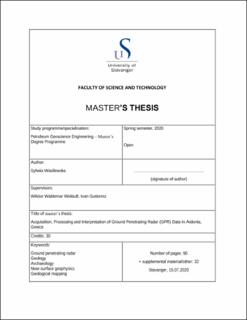| dc.contributor.advisor | Weibull, Wiktor Waldemar | |
| dc.contributor.advisor | Gutierrez, Ivan | |
| dc.contributor.author | Wasilewska, Sylwia | |
| dc.coverage.spatial | Greece, Aidonia | en_US |
| dc.date.accessioned | 2020-10-13T09:15:51Z | |
| dc.date.available | 2020-10-13T09:15:51Z | |
| dc.date.issued | 2020 | |
| dc.identifier.uri | https://hdl.handle.net/11250/2682393 | |
| dc.description | Master's thesis in Petroleum Geosciences Engineering | en_US |
| dc.description.abstract | The Mycenaean Cemetery of Aidonia, Greece, is located about 10 km west of the town of New Nemea on the Peloponnese peninsula. In this cemetery, a number of chamber tombs dating from 1600-1100 B.C. was discovered in the late 1970s and excavated after many of the tombs were plundered by looters.
The Aidonia Cemetery is still being excavated today, but the area has not been thoroughly investigated geologically. This study uses ground penetrating radar (GPR) to investigate the shallow subsurface of the cemetery, as well as investigating any archaeological artefacts. In addition to GPR, geological field mapping was done correlate with the GPR data and ultimately provide a better understanding of the local geology in the cemetery and its vicinity.
In this study, a complete workflow that encompasses acquisition, processing, and interpretation of GPR data is provided. The final GPR dataset consisted of 89 lines in the Middle and Upper Cemetery, where nine areas (features) were interpreted in the data. In addition to this, over 400 small-scale faults in individual lines, and 33 wipeout zones were interpreted throughout the data. The main challenges in this study were the high absorption of electromagnetic waves in the GPR survey, as well as inaccurate GPS coordinates. A geological field map of the study area was created, with focus on the Aidonia Cemetery; it was found that four units with six different lithologies were observed in the study area.
It was found that wipeout zones could indicate a higher water saturation or an infill, both of either natural or anthropogenic origins. Some wipeouts correlated with already excavated tombs. Individual faults can possibly be combined and interpreted as fracture planes. Features can correlate to a harder, more consolidated lithology, as indicated on the geological map of the study area.
Future studies in this area would require an external GPS antenna and can be conducted with a higher-frequency GPR antenna for better resolution, as well as collection of samples to study the petrophysical properties of the rocks in the study area. | en_US |
| dc.language.iso | eng | en_US |
| dc.publisher | University of Stavanger, Norway | en_US |
| dc.relation.ispartofseries | Masteroppgave/UIS-TN-IER/2020; | |
| dc.rights | Navngivelse 4.0 Internasjonal | * |
| dc.rights.uri | http://creativecommons.org/licenses/by/4.0/deed.no | * |
| dc.subject | petroleumsgeologi | en_US |
| dc.subject | ground penetrating radar | en_US |
| dc.subject | gpr | en_US |
| dc.subject | geology | en_US |
| dc.subject | archaeology | en_US |
| dc.subject | near-surface geophysics | en_US |
| dc.subject | geological mapping | en_US |
| dc.subject | arkeologi | en_US |
| dc.subject | Hellas | en_US |
| dc.title | Acquisition, Processing and Interpretation of Ground Penetrating Radar (GPR) Data in Aidonia, Greece | en_US |
| dc.type | Master thesis | en_US |
| dc.rights.holder | Sylwia Wasilewska | en_US |
| dc.subject.nsi | VDP::Teknologi: 500::Berg‑ og petroleumsfag: 510::Geoteknikk: 513 | en_US |
| dc.subject.nsi | VDP::Matematikk og Naturvitenskap: 400::Geofag: 450::Petroleumsgeologi og -geofysikk: 464 | en_US |

